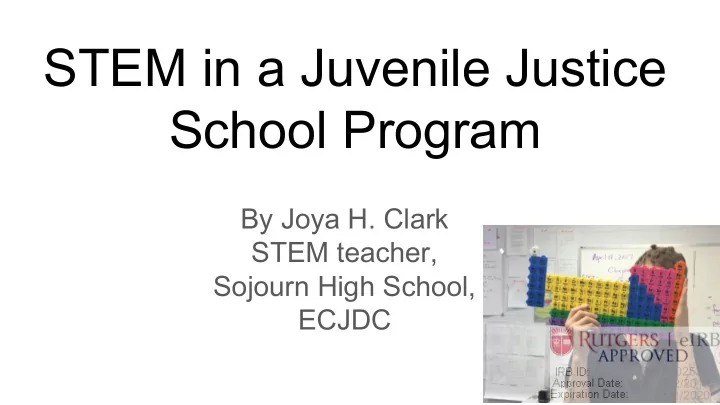

STEM in a Juvenile Justice School Program By Joya H. Clark STEM teacher, Sojourn High School, ECJDC Pro2018002522 5/2/2019 5/1/2020
What does STEM stand for? Science - Traditional subjects such as Biology, Chemistry, Earth Science, and Physics. Technology - Newer subjects that have been added to the curriculum such as computer programming, computer-aided design and 3D printing, or robotics. Engineering - designing new technology and revising the old. Mathematics - the abstract science of number, quantity, and space. Pro2018002522 5/2/2019 5/1/2020
Key Definitions from the NRC In the K–12 context, “science” is generally taken to mean the traditional natural sciences: physics, chemistry, biology, and (more recently) earth, space, and environmental sciences . . . . Pro2018002522 5/2/2019 5/1/2020
Engineering & Technology We use the term “engineering” in a very broad sense to mean any engagement in a systematic practice of design to achieve solutions to particular human problems. Likewise, we broadly use the term “technology” to include all types of human-made systems and processes—not in the limited sense often used in schools that equates technology with modern computational and communications devices. Pro2018002522 5/2/2019 5/1/2020
Where do the engineers come in? Technologies result when engineers apply their understanding of the natural world and of human behavior to design ways to satisfy human needs and wants. (NRC 2012, p. 11-12) Pro2018002522 5/2/2019 5/1/2020
What’s the Big Deal? Isn’t that what we’ve always done? Sort of ... Most science and math teachers have talked about it as a career, but very few actually tried to integrate it into their lessons until our standards changed. In other words, when the Next Generation Science Standards were introduced, science and engineering practices became the rule instead of the exception. Now, we are all challenged to integrate these three components of engineering design into all science instruction: Pro2018002522 5/2/2019 5/1/2020
Components of Engineering Design A. Defining and delimiting engineering problems involves stating the problem to be solved as clearly as possible in terms of criteria for success, and constraints or limits. B. Designing solutions to engineering problems begins with generating a number of different possible solutions, then evaluating potential solutions to see which ones best meet the criteria and constraints of the problem. C. Optimizing the design solution involves a process in which solutions are systematically tested and refined and the final design is improved by trading off less important features for those that are more important. Pro2018002522 5/2/2019 5/1/2020
Why should we try to teach engineering? Isn’t that Physics? In our context, many students do not see the relevance of school. Engineering projects are focused on solving practical, real-world problems. In most cases, students are willing to engage. Yes, engineering involves physics, but most projects can be completed with an explanation of the application of physics, even before students attempt to solve any physics problems. Pro2018002522 5/2/2019 5/1/2020
Can students in this setting even handle this? Sure, they can. It takes a ton of time and patience. Pro2018002522 5/2/2019 5/1/2020
Will students learn anything that they can actually use? Absolutely, yes! They can learn about construction, cosmetology, electrical & electronics, computer programming, and architecture. What ideas do you have? Pro2018002522 5/2/2019 5/1/2020
How do we get started? We use technology to connect our science and math teachers! I am here today to request your permission to create secure meeting space for us to meet. ● Password protected ● Virtual Coaching Model ● Utilizing Office 365 What would be a “dream come true” for you to support your science and math teachers? Pro2018002522 5/2/2019 5/1/2020
If you want to get started, I can help Some of the things I love the most for engineering are free! Such as: ● https://codecombat.com/ ● https://scratch.mit.edu/ ● https://www.ck12.org/student/ ● https://www.summitlearning.org/ Some of them are inexpensive: Less than $20: https://www.kiwico.com/tinker Expensive, but really worth it: $2,400 for 100 student licenses: https://www.ixl.com/ Pro2018002522 5/2/2019 5/1/2020
Please reach out to me Joya Clark E-mail: j.clark@eresc.com, or jc346@njit.edu Mobile Phone: (973) 951-9263 Sojourn High School 80 Duryea Street Newark, NJ 07103 Pro2018002522 5/2/2019 5/1/2020
Recommend
More recommend